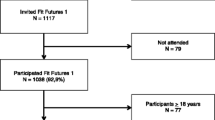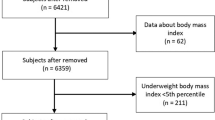Abstract
Summary
Low/reduced bone mineral density (BMD) is an important predictor of childhood fracture. In this article, we presented the prevalence of BMD in Chinese adolescents and, for the first time, demonstrated the gender disparities in the impact of height on BMD.
Purpose
To analyze the gender disparities in the association of low/reduced BMD with height in Chinese adolescents at the stage of growth spurt.
Methods
A total of 8152 adolescents aged 12–14 years old were included based on a cross-sectional study in Tianjin, China. Height and weight were measured with standard equipment. BMD was measured using the method of quantitative ultrasound. Adolescents with Z ≤ − 2.0 or − 2.0 < Z ≤ − 1.0 were defined as “low BMD” or “reduced BMD”.
Results
The total low/reduced BMD rate was 22.0% in Chinese adolescents aged 12–14 years old, and boys were more likely to have low/reduced BMD than girls (30.1% vs. 12.9%, P < 0.001). The rate of low/reduced BMD significantly increased with age in boys (Ptrend = 0.019), whereas decreased with age in girls (Ptrend = 0.018). We found significant interaction effect between gender and height standard deviation score (height-Z) in the association with low/reduced BMD (Pinteraction < 0.001). There was a positive association of height-Z among boys (OR = 1.30, 95%CI 1.21–1.39, P < 0.001), meanwhile low/reduced BMD was inversely associated with height-Z among girls (OR = 0.85, 95%CI 0.78–0.94, P < 0.001).
Conclusions
Our study suggested strong gender disparities in the impact of height on BMD in Chinese adolescents aged 12-14 years old, where the association between low/reduced BMD and height was positive among boys but inverse among girls. The study provides evidence on the early prevention and the risk factor identification of low/reduced BMD and childhood fractures.

Similar content being viewed by others
References
NIH Consensus Development Panel on Osteoporosis Prevention D, Therapy (2001) Osteoporosis prevention, diagnosis, and therapy. JAMA. 285(6):785–795
Naranje SM, Erali RA, Warner WC Jr, Sawyer JR, Kelly DM (2016) Epidemiology of pediatric fractures presenting to emergency departments in the United States. J Pediatr Orthop 36(4):e45–e48
Hedstrom EM, Svensson O, Bergstrom U, Michno P (2010) Epidemiology of fractures in children and adolescents. Acta Orthop 81(1):148–153
Moustaki M, Lariou M, Petridou E (2001) Cross country variation of fractures in the childhood population. Is the origin biological or “accidental”? Inj Prev 7(1):77
Cooper C, Dennison EM, Leufkens HG, Bishop N, van Staa TP (2004) Epidemiology of childhood fractures in Britain: a study using the general practice research database. J Bone Miner Res 19(12):1976–1981
Spady DW, Saunders DL, Schopflocher DP, Svenson LW (2004) Patterns of injury in children: a population-based approach. Pediatrics. 113(3 Pt 1):522–529
Naka H, Iki M, Morita A, Ikeda Y (2005) Effects of pubertal development, height, weight, and grip strength on the bone mineral density of the lumbar spine and hip in peripubertal Japanese children: Kyoto kids increase density in the skeleton study (Kyoto KIDS study). J Bone Miner Metab 23(6):463–469
Munaisinghe RL, Botea V, Edelson GW (2002) Association among age, height, weight, and body mass index with discordant regional bone mineral density. J Clin Densitom 5(4):369–373
Bailey DA, McKay HA, Mirwald RL, Crocker PR, Faulkner RA (1999) A six-year longitudinal study of the relationship of physical activity to bone mineral accrual in growing children: the University of Saskatchewan bone mineral accrual study. J Bone Miner Res 14(10):1672–1679
Faulkner RA, Davison KS, Bailey DA, Mirwald RL, Baxter-Jones AD (2006) Size-corrected BMD decreases during peak linear growth: implications for fracture incidence during adolescence. J Bone Miner Res 21(12):1864–1870
Barzilay JI, Buzkova P, Cauley JA, Robbins JA, Fink HA, Mukamal KJ (2018) The associations of subclinical atherosclerotic cardiovascular disease with hip fracture risk and bone mineral density in elderly adults. Osteoporos Int 29(10):2219–2230
To WW, Wong MW (2012) Bone mineral density changes during pregnancy in actively exercising women as measured by quantitative ultrasound. Arch Gynecol Obstet 286(2):357–363
Atteritano M, Lasco A, Mazzaferro S, Macri I, Catalano A, Santangelo A et al (2013) Bone mineral density, quantitative ultrasound parameters and bone metabolism in postmenopausal women with depression. Intern Emerg Med 8(6):485–491
Alwis G, Rosengren B, Nilsson JA, Stenevi-Lundgren S, Sundberg M, Sernbo I, Karlsson MK (2010) Normative calcaneal quantitative ultrasound data as an estimation of skeletal development in Swedish children and adolescents. Calcif Tissue Int 87(6):493–506
Rauch F, Plotkin H, DiMeglio L, Engelbert RH, Henderson RC, Munns C, Wenkert D, Zeitler P (2008) Fracture prediction and the definition of osteoporosis in children and adolescents: the ISCD 2007 Pediatric Official Positions. J Clin Densitom 11(1):22–28
Shaiykova A, Pasquet A, Goujard C, Lion G, Durand E, Bayan T, Lachâtre M, Choisy P, Ajana F, Bourdic K, Viget N, Riff B, Quertainmont Y, Cortet B, Boufassa F, Chéret A (2018) Reduced bone mineral density among HIV-infected, virologically controlled young men: prevalence and associated factors. AIDS. 32:2689–2696
Whiting SJ, Vatanparast H, Baxter-Jones A, Faulkner RA, Mirwald R, Bailey DA (2004) Factors that affect bone mineral accrual in the adolescent growth spurt. J Nutr 134(3):696S–700S
Yeh LR, Chen CK, Lai PH (2004) Normal bone mineral density in anteroposterior, lateral spine and hip of Chinese men in Taiwan: effect of age change, body weight and height. J Chin Med Assoc 67(6):287–295
Fewtrell MS, Gordon I, Biassoni L, Cole TJ (2005) Dual X-ray absorptiometry (DXA) of the lumbar spine in a clinical paediatric setting: does the method of size-adjustment matter? Bone. 37(3):413–419
Leonard MB, Shults J, Elliott DM, Stallings VA, Zemel BS (2004) Interpretation of whole body dual energy X-ray absorptiometry measures in children: comparison with peripheral quantitative computed tomography. Bone. 34(6):1044–1052
Acknowledgements
The authors thank all the adolescents who participated in the Youth Health Care Promotion Program (YHCPP).
Author information
Authors and Affiliations
Corresponding authors
Ethics declarations
Conflict of interest
None.
Ethics approval and consent to participate
The study was approved by the Ethics Committee of Tianjin Women’s and Children’s Health Center, and written informed consent was provided by all participants.
Additional information
Publisher’s note
Springer Nature remains neutral with regard to jurisdictional claims in published maps and institutional affiliations.
Rights and permissions
About this article
Cite this article
Yu, C., Wang, S., Meng, X. et al. The impact of height on low/reduced bone mineral density in Chinese adolescents aged 12-14 years old: gender differences. Arch Osteoporos 14, 78 (2019). https://doi.org/10.1007/s11657-019-0606-1
Received:
Accepted:
Published:
DOI: https://doi.org/10.1007/s11657-019-0606-1




